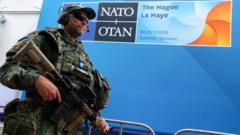Will Germany Step Up for Europe's Defence at the Hague Summit?

Understanding the Significance of the NATO Summit in The Hague
The NATO summit in The Hague has emerged as a pivotal moment in international relations, particularly in the context of escalating tensions in Eastern Europe. With Germany's Chancellor Friedrich Merz warning that Russian President Vladimir Putin understands only the language of force, the stakes have never been higher for NATO member states. This summit, described as "historic," aims to address the security landscape of Europe and ensure peace for generations to come. The commitment to defense spending is a focal point, as all 32 leaders prepare to discuss crucial strategies to counter ongoing threats.
The Context of the Summit: A World Divided
The backdrop of the NATO summit is marked by numerous geopolitical tensions, notably the ongoing conflict in Ukraine. As of the latest reports, Russian attacks resulted in casualties, with ten lives lost in a single day. This scenario underscores the urgency for NATO to solidify its collective stance against aggression. Chancellor Merz's declaration that Berlin will pay its "fair share" to defend Europe illustrates the shifting dynamics within the alliance, as the need for increased military spending becomes increasingly critical.
The Challenges Posed by Russia
Putin’s ambitions regarding Ukraine remain a significant concern for NATO countries. The Russian president has made it clear that he views Ukraine as an integral part of Russia, and efforts to bring him to the negotiating table have failed repeatedly. This notion propels the urgency of the NATO summit, as leaders seek to develop robust strategies for deterrence and defense.
- Increased military presence in Eastern Europe
- Enhanced support for Ukraine, including military aid
- Commitment to long-term defense strategies
The U.S. Role in NATO: A Double-Edged Sword
The participation of U.S. President Donald Trump in this summit adds another layer of complexity. His administration's approach to NATO has often been characterized by a demand for increased spending from European allies. During the summit, all 32 leaders are expected to commit to spending 3.5% of their national output on defense, alongside an additional 1.5% for related infrastructure. This ambitious goal reflects a shift in NATO's defense strategy, seeking to bolster collective security amidst rising threats.
The Financial Commitment: A New Benchmark for NATO
The proposed 5% defense investment target marks a significant increase from the current 2% guideline. However, this target raises questions about feasibility, as many member states lag in their current defense spending. Out of the 32 allies, 27 spend less than 3%, with several hovering below the minimum 2% threshold set in 2014. This situation necessitates substantial budget adjustments and strategic planning among member nations.
Germany’s Commitment: A New Era of Defense Spending
The German government has recently backed a budget deal aimed at achieving the 3.5% defense spending target by 2029. With plans to allocate €62.4 billion for defense in 2025, rising to €152.8 billion by 2029, Germany’s commitment signals a serious dedication to NATO’s collective security. Merz emphasized that this commitment is not merely a favor to the U.S. but rather a necessary step to safeguard the Euro-Atlantic region from Russian aggression.
The Broader Implications for Europe
As NATO members prepare to ratify the new investment plan, the implications stretch beyond mere numbers. The commitment to defense spending is a reflection of a collective understanding that security threats are evolving and require a united front. This sentiment was echoed by UK Prime Minister Keir Starmer, who reiterated the importance of agility and speed in navigating the current geopolitical landscape.
Challenges Faced by Member States
Despite the overarching commitment to increased defense spending, not all nations are on the same page. Countries like Spain have expressed resistance to meeting the new spending targets, citing domestic challenges and political implications. The reluctance to increase defense budgets reflects a broader debate within NATO regarding the balance between national interests and collective security commitments.
- Spain's defense spending currently stands below 1.3%
- Political resistance among governing coalitions
- Concerns regarding public opinion on increased military spending
The Importance of Unified Strategy
In light of these challenges, NATO Secretary General Mark Rutte has emphasized the need for a unified strategy among member states. His insistence that all countries must work towards the 3.5% target reflects a commitment to solidarity within the alliance. However, questions remain about how to effectively implement these strategies amid differing national priorities.
Operational Security: Addressing Emerging Threats
As NATO leaders convene, operational security remains a priority. The recent disruptions to train travel in the Netherlands, attributed to potential sabotage, highlight the vulnerabilities that NATO must address. The security and logistics of the summit itself serve as a reminder of the ongoing threats that member states face, both from external aggression and internal challenges.
Cybersecurity: A New Frontier in Defense
The evolving nature of warfare necessitates a comprehensive approach that includes cybersecurity as a key component of defense strategies. The inclusion of defense-related expenditures in the new spending targets reflects this understanding. Investments in cybersecurity, intelligence, and infrastructure will be critical as NATO adapts to the changing landscape of threats.
The Future of NATO: A Call for Unity and Resilience
The NATO summit in The Hague represents not just a meeting of leaders but a crucial juncture for the future of international security. As member states grapple with the implications of increased defense spending and mounting geopolitical tensions, the commitment to unity and resilience will be tested. The decisions made in the coming days will shape the security framework of Europe for generations to come.
FAQs
What is the primary goal of the NATO summit in The Hague?
The primary goal is to solidify defense commitments among member states to ensure peace and security in Europe, particularly in light of ongoing threats from Russia.
How much are NATO members expected to spend on defense?
NATO members are expected to commit to spending 3.5% of their national output on defense, with an additional 1.5% on related infrastructure.
What challenges do member states face in meeting the new spending targets?
Challenges include political resistance, public opinion on increased military spending, and the need for significant budget adjustments.
Why is cybersecurity important for NATO?
Cybersecurity is crucial as the nature of warfare evolves; threats increasingly come from cyber attacks, necessitating comprehensive defense strategies that include digital security measures.
Conclusion: The Path Forward for NATO and Europe
As the NATO summit unfolds, it serves as a critical reminder of the complexities of global security. The commitment to increased defense spending and the call for unity among member states highlight the seriousness of the current geopolitical landscape. With rising tensions and security threats, the decisions made at this summit will shape the future of NATO and European security for decades to come. How will NATO adapt to these challenges and ensure the safety of its member states? The answers will be revealed in the discussions and agreements reached in The Hague.
#NATOSummit #EuropeanSecurity #DefenceStrategy
Published: 2025-06-24 13:09:17 | Category: technology



